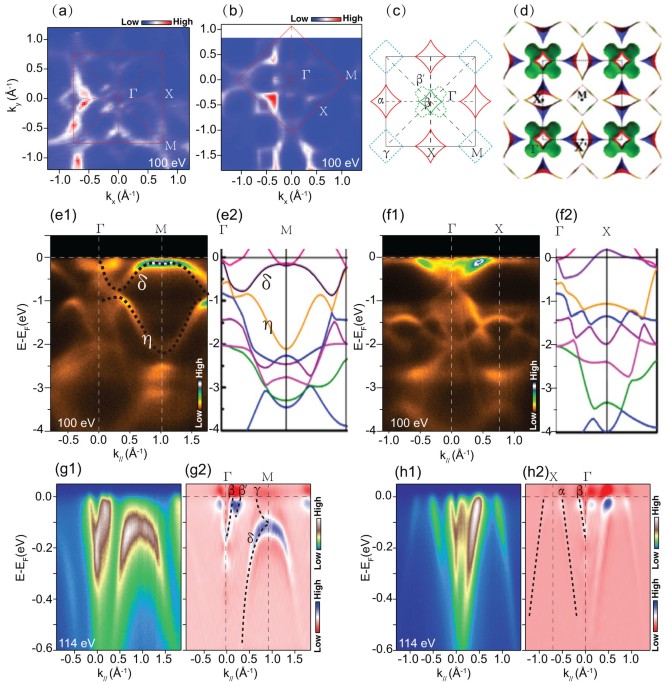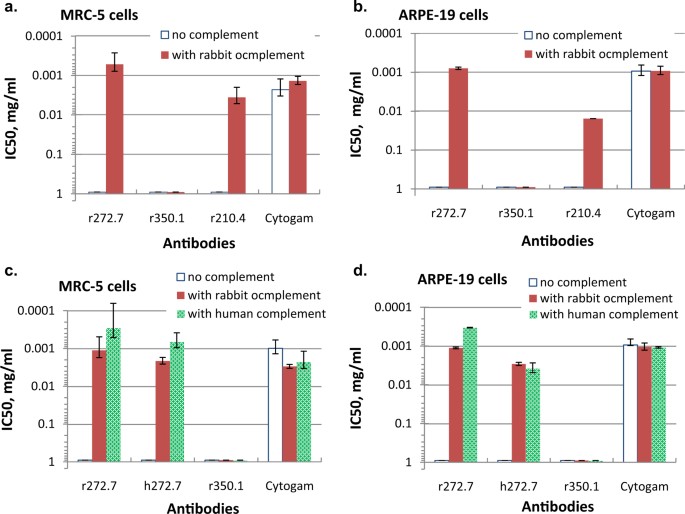
- Select a language for the TTS:
- UK English Female
- UK English Male
- US English Female
- US English Male
- Australian Female
- Australian Male
- Language selected: (auto detect) - EN
Play all audios:
ABSTRACT The electronic structure of Na2Ti2Sb2O single crystal is studied by photon energy and polarization dependent angle-resolved photoemission spectroscopy (ARPES). The obtained band
structure and Fermi surface agree well with the band structure calculation of Na2Ti2Sb2O in the non-magnetic state, which indicates that there is no magnetic order in Na2Ti2Sb2O and the
electronic correlation is weak. Polarization dependent ARPES results suggest the multi-band and multi-orbital nature of Na2Ti2Sb2O. Photon energy dependent ARPES results suggest that the
electronic structure of Na2Ti2Sb2O is rather two-dimensional. Moreover, we find a density wave energy gap forms below the transition temperature and reaches 65 meV at 7 K, indicating that
Na2Ti2Sb2O is likely a weakly correlated CDW material in the strong electron-phonon interaction regime. SIMILAR CONTENT BEING VIEWED BY OTHERS UNVEILING THE ORBITAL TEXTURE OF 1T-TITE2 USING
INTRINSIC LINEAR DICHROISM IN MULTIDIMENSIONAL PHOTOEMISSION SPECTROSCOPY Article Open access 15 November 2021 PROBING TOPOLOGICAL FLOQUET STATES IN WSE2 USING CIRCULAR DICHROISM IN TIME-
AND ANGLE-RESOLVED PHOTOEMISSION SPECTROSCOPY Article Open access 27 June 2022 INCOHERENCE-TO-COHERENCE CROSSOVER OBSERVED IN CHARGE-DENSITY-WAVE MATERIAL 1_T_-TISE2 Article Open access 24
October 2024 INTRODUCTION Layered compounds of transition-metal elements always show interesting and novel electric and magnetic properties and have been studied extensively. The discovery
of basic superconducting layers, such as the CuO2 plane1 in cuprates and Fe2An2 (An = P, As, S, Se, Te) layers2 in iron based superconductors, have opened new fields in physics and chemistry
of layered superconductors. Recently another class of layered compounds built from alternatively stacking of special conducting octahedral layers Ti2Pn2O (Pn = Sb, As) and certain charge
reservoir layers [e.g., Na2, Ba, (SrF)2, (SmO)2] have attracted much attention3,4,5,6,7,8,9,10,11,12,13,14,15,16,17. Most notably, these compounds exhibit competing phases just like in
cuprates and iron based superconductors. Both experiments and band calculations show that the ground states of Na2Ti2Sb2O (Refs. 6, 9, 18–19) and BaTi2Sb2O (Refs. 12, 13, 20, 21) are
possible spin-density wave (SDW) or charge-density wave (CDW) phases and the Na+ substitution of Ba2+ in NaxBa1-xTi2Sb2O suppresses the CDW/SDW and leads to superconductivity, whose critical
temperature (_T_c) can be as high as 5.5 K for x = 0.15 (Refs. 13). These layered compounds provide a new platform to study unconventional superconductivity. Na2Ti2Sb2O is a sister compound
to BaTi2Sb2O, which shows a phase transition at _T_s~115 K as characterized by a sharp jump in resistivity and a drop in spin susceptibility3. The microscopic mechanism for this phase
transition has not been determined, but it has been suggested to arise from the SDW or CDW instability driven by the strongly nested electron and hole Fermi surfaces (Refs. 18–23). However,
the nature of the phase transition and its correlation with the superconductivity are still unknown. A recent DFT calculation23 predicted possible SDW instabilities in Na2Ti2Pn2O (Pn = As,
Sb) and more specifically that the ground states of Na2Ti2Sb2O and Na2Ti2As2O are bi-collinear antiferromagnetic semimetal and novel blocked checkerboard antiferromagnetic semiconductor,
respectively. An optical study24 reveals a significant spectral change across the phase transition and the formation of a density-wave-like energy gap. However, one cannot distinguish
whether the ordered state is CDW or SDW since both states have the same coherent factor. To date, the experimental electronic structure of Na2Ti2Sb2O has not been reported, which is critical
for understanding the nature of the density waves in these compounds. In this article, we investigate the electronic structure of Na2Ti2Sb2O with angle-resolved photoemission spectroscopy
(ARPES). Our polarization and photon energy dependent studies reveal the multi-orbital and weak three-dimensional nature of this material. The obtained band structure and Fermi surface agree
well with the band structure calculation of Na2Ti2Sb2O in the non-magnetic state, which indicates that there is no magnetic order in Na2Ti2Sb2O and the electronic correlation is weak.
Temperature dependent ARPES results reveal that a density wave energy gap forms below the transition temperature and reaches 65 meV at 7 K, indicating that Na2Ti2Sb2O is likely a weakly
correlated CDW material in the strong electron-phonon interaction regime. RESULTS BAND STRUCTURE The electronic structure of Na2Ti2Sb2O at 15 K is presented in Fig. 1. Photoemission
intensity maps are integrated over a [_E_F - 10 meV, _E_F + 10 meV] window around the Fermi energy (_E_F) as shown in Figs. 1(a) and 1(b). The azimuth angle of the sample in Fig. 1(b) was
rotated by 45° compared with in Fig. 1(a), there is subtle spectrum weight difference in the two obtained Fermi surface maps due to the matrix element effect. The observed Fermi surface
consists of four square-shaped hole pockets (α) centered at X and four similar electron pockets (γ) centered at M. The electronic structure around Γ is more complicated, mainly consists of a
diamond-shaped (β) and a four-leaf clover like (β′) electron pockets. The extracted Fermi surface from photoemission intensity map and the theoretic predicted Fermi surface are shown in
Figs. 1(c) and 1(d), which agree well with each other. The calculated Fermi surface of Na2Ti2Sb2O in the non-magnetic state was taken from Ref. 23. The Fermi pockets centered at X and M show
multiple parallel sections, providing possible Fermi surface nesting condition for density wave instabilities, as suggested in previous first principle calculations23. The valence band
structures of Na2Ti2Sb2O along Γ-M and Γ-X are present in Figs. 1(e1) and 1(f1). The valence band structures agree qualitatively well with the calculations23 in non-magnetic state (Figs.
1(e2) and 1(f2)). Taking two distinct bands δ and η as examples, the renormalization factors are very close to 1 for both bands, suggesting the weak correlation character of Na2Ti2Sb2O.
Figs. 1(g) and (h) show the low energy electronic structure along the Γ-M and Γ-X directions together with their second derivative spectrum. The band structure as indicated by the dashed
curves in Figs. 1(g2) and (h2) are resolved by tracking the local minimum locus in the second derivative of the ARPES intensity plot with respect to energy. A weak but dispersive electron
band can be resolved around M point, its band bottom locate at the top of a hole-like band δ. Two nearly coincident electron-like bands (β and β′) can be resolved around Γ point at certain
photon energy along the Γ-M direction, while there is only one electron-like band β across _E__F_ near Γ along the Γ-X direction. A hole-like band α crosses _E__F_ and forms the
square-shaped pockets around X. The overall measured electronic structure of Na2Ti2Sb2O agrees well with the calculations and the near-unity renormalization factor suggests that the ground
state of Na2Ti2Sb2O is nonmagnetic and the correlation is weak. POLARIZATION DEPENDENCE The electronic structure of Na2Ti2Sb2O near _E_F is mainly contributed by Ti 3_d_ orbitals, which is
similar to the case of iron based superconductors. We conducted the polarization dependent photoemission spectroscopy measurement to resolve the possible multi-orbital nature of Na2Ti2Sb2O.
The experimental setup for polarization-dependent ARPES is shown in Fig. 2(a). The incident beam and the sample surface normal define a mirror plane. For the _s_ (or _p_) experimental
geometries, the electric field of the incident photons is out of (or in) the mirror plane. The matrix element for the photoemission process could be described as: Since the final state of
photoelectrons could be approximated by a plane wave with its wave vector in the mirror plane, is always even with respect to the mirror plane in our experimental geometry. In the _s_ (or
_p_) geometry, is odd (or even) with respect to the mirror plane. Thus considering the spatial symmetry of the Ti 3_d_ orbitals, when the analyzer slit is along the high-symmetry directions,
the photoemission intensity of specific even (or odd) component of a band is only detectable with the _p_ (or _s_) polarized light. For example, with respect to the mirror plane (the _xz_
plane), the even orbitals (_d__xz_, and ) and the odd orbitals (_d__xy_ and _d__yz_) could be only observed in the _p_ and _s_ geometries, respectively. The photoemission intensity plots of
Na2Ti2Sb2O along the Γ-M and Γ-X high symmetry directions are shown in Fig. 2. The incident _C+_ light is a mixture of both the _p_ and _s_ polarizations, so all the bands with specific
orbital can be seen with the _C+_ incident light. The β band at Γ is absent in the _s_ polarization along the Γ-M direction, visible in both polarizations along the Γ-X direction, which may
be attributed to the Ti _d__xz_ orbital. The electron band γ only shows up on the _s_ polarization at the M point, exhibiting its odd nature with respect to the mirror plane, which may be
attributed to the _d__yz_ and/or _d__xy_ orbital. The hole-like band at X point is not as pure, it is visible in the _p_ polarization along the Γ-X direction, hardly seen in the _s_
polarization, which may be a mixture of different Ti 3_d_ orbitals. In general, Na2Ti2Sb2O exhibits obvious polarization dependence, which resembles the multi-band and multi-orbital nature
of band structure of iron pnictide superconductors25. _K_Z DEPENDENCE The calculated electronic structure of Na2Ti2Sb2O shows typical two dimensional character by the nearly _k_z-independent
Fermi surface sheets around the X and M points, while the electronic structure exhibit significant kz dispersion at Γ point22,23. To study the three-dimensional character of the electronic
structure in Na2Ti2Sb2O, we have conducted the photon energy dependent experiment with circularly polarized photons. The measured band structures along the two high-symmetry directions (Γ-M
and Γ-X) with different photon energies are present in Fig. 3. Figs. 3(a) and (d) show the band dispersion and Fermi crossing along the Γ-X direction, where an electron-like band marked as β
and a hole-like band marked as α cross the Fermi energy. The Fermi crossings of bands are determined by tracking the peak positions in the MDCs taken at various photon energies. The Fermi
crossings of α and β bands both show weak _k_z dispersion with a typical cycle of each 14 eV photon energy. The Fermi momentum of β reaches its minimum at 90 eV photon energy, then increases
with increasing photon energy and reaches its maximum at 104 eV. On the contrary, the Fermi momentum of α band reaches its maximum and minimum at 90 eV and 104 eV, respectively. Consistent
with the measured Fermi surface, there is only one electron band near Γ along the Γ-X direction (labeled as β), while we can clearly observe two electron bands along the Γ-M direction
(labeled as β and β′). The Fermi crossings of β and β′ show negligible photon energy dependence along Γ-M, while the relative intensity of β and β′ change with photon energy. For instance at
104 eV, the β′ intensity is high, while the β intensity is low. With increasing photon energy, the intensity of β′ decreases while that of β increases, reaching their minimum and maximum at
118 eV, respectively. The relative intensity instead of Fermi crossing shows distinct photon energy dependence for β and β′. For the γ band near the M point, its Fermi momentum shows weak
kz dispersion, with the minimum and maximum at 104 eV and 118 eV, respectively. The theoretic predicted Fermi surface of Na2Ti2Sb2O shows cylinder Fermi sheets near M and X and strong _k_z
dependent Fermi sheet near Γ22,23, our photoemission data confirmed the two dimensional character of the electronic structure at X and M. The weak photon energy dependence of the electronic
structure at Γ is not consistent with the theoretic calculation and this discrepancy may be due to the poor _k_z resolution of our ARPES experiment in the vacuum ultra-violet photon energy
range. It is known that the poor _k_z resolution would largely smear out the dispersive information along _k_z for a fast-dispersive band, as likely observed here. FORMATION OF THE DENSITY
WAVE ENERGY GAP In the conventional picture of density wave transition, the formation of electron-hole pairs with a nesting wave vector connecting different regions of FSs would lead to the
opening of an energy gap. In charge-density wave systems such as 2H-TaS2, strong electron–photon interactions could cause incoherent polaronic spectral lineshape and large Fermi patches
instead of a clear-cut Fermi surface26. Anomalous temperature dependent spectral weight redistribution and broad lineshape with incoherent character was reported in BaTi2As2O (Ref. 27), an
iso-structural compound of Na2Ti2Sb2O. It was found that partial energy gap opens at the Fermi patches, instead of Fermi surface nesting, is responsible for the CDW in BaTi2As2O. The
detailed temperature dependence of the low energy electronic structure of Na2Ti2Sb2O is presented in Fig. 4. The Fermi surface topologies of Na2Ti2Sb2O at 150 K and 7 K are rather similar,
but a dramatic spectra weight change can be observed around the X point. At 150 K, which is above the phase transition temperature 115 K, the spectra weight around X is quite strong compared
with those around the Γ point. At 7 K, which is well below the transition, the spectral weight near X is obviously suppressed, while it was slightly enhanced near Γ. Fig. 4(c) shows the
symmetrized spectrum along Γ-X. The band dispersion shows much alike at both temperatures, but an energy gap opens at X point when it comes into the CDW/SDW state at 7 K. We tracked the EDCs
at the Fermi crossing of α band to reveal the CDW/SDW gap opening behavior more precisely. The density of states near _E_F is obviously suppressed with decreasing temperature[Fig. 4(d)]; an
energy gap opens at 113 K below the phase transition temperature of 115 K for Na2Ti2Sb2O[Fig. 4(e)]. The gap size increased with decreasing temperature, following the typical BCS
formula[Fig. 4(f)]. The gap size get saturated at low temperature and the largest gap size is about 65 meV at 7 K, which give a large ratio of 2Δ/kBTs~13. The optical study24 revealed
2Δ/kBTs ~14, in consistent with our findings. Such a large ratio indicates that this density wave system is in the strong electron–photon coupling regime27. Intriguingly, the photoemission
spectrum of the electron band β around Γ shows a broad line shape without a sharp quasiparticle peak near _E_F and the spectral weight increases slightly with deceasing temperature [Fig.
4(g)]. Furthermore, the peak position moves slightly upward to _E_F with deceasing temperature. The spectral weight enhancement for β band shows a gradual change behavior with decreasing
temperature, indicating that it is not relevant to the density wave transition around 115 K. Compared with the obvious gap opening behavior at X, it is safe to conclude that the gap does not
open near Γ. In consideration of the theoretic prediction that X and M show multiple parallel sections, it is nature to deduce that Fermi surface nesting may happen between the parallels
sections of X and M. Due to the matrix element effects, the spectral weight near M is extremely weak for data taken with 21.2 eV photons, we thus cannot access the temperature dependence
there. In the sibling compound BaTi2As2O (Ref. 27), large energy scale spectral weight transfer with broad lineshape was reported. With decreasing temperature, some parts of the bands in
BaTi2As2O get suppressed through the CDW transition, while some parts of the bands get enhanced. Similar large-scale spectral weight redistribution was also observed previously in Sr2CuO2Cl2
(Ref. 29), which is explained by multiple initial/final states induced by strong coupling between electrons and bosons. In the case of Na2Ti2Sb2O, the electron band β around Γ[Fig. 4(g)]
and the hole band α around X [Fig. 4(d)]both show broad line shape without sharp quasiparticle peak near _E_F, whose typical full width at half maximum (FWHM) are about 100~150 meV. These
behaviors have been found to be typical signatures of polaronic systems, such as La1.2Sr1.8Mn2O7 (Ref. 30) and K0.3MoO3 (Ref. 31), where the weight of the quasiparticle peak is vanishingly
small and its dispersion is renormalized to the vicinity of the Fermi surface. Similar to BaTi2As2O, some part of the bands (α band) in Na2Ti2Sb2O get significantly suppressed with
decreasing temperature, while some part of the bands (β band) get slightly enhanced, through which the total electronic energy is saved crossing the CDW transition. Different from BaTi2As2O,
we have observed clear CDW gap formation and possible Fermi surface nesting condition in Na2Ti2Sb2O, which prefer the traditional Fermi surface nesting mechanism. Na2Ti2Sb2O is somewhat an
intriguing combination of traditional CDW materials and polaronic materilas, where Fermi surface nesting and polaronic behaviors are present at the same time in one material. DISCUSSION It
is crucial to understand the nature of the phase transition in the parent compounds of the newly discovered titanium-based oxypnictide superconductors, which is an essential step towards a
thorough understanding of their superconducting mechanism. The SDW origin of the instability would favor an unconventional superconductivity with a possibly sign-changing _s_-wave pairing,
while the CDW origin would suggest more conventional superconductivity with a simple _s_-wave pairing. Previous experimental and theoretical studies have evoked much controversy on the
nature of the possible density wave transition. Our photoemission results are consistent with the density wave origin of the phase transition in Na2Ti2Sb2O. Moreover, considering the
qualitative agreement of the experimental results and the calculated electronic structure23 in the nonmagnetic states and it is reasonable to deduce that it is possibly a conventional CDW
transition in Na2Ti2Sb2O. Although further low temperature ARPES or STM experiment is certainly needed to reveal the exact nature of the superconducting samples, one can speculate that the
superconductivity in NaxBa1-xTi2Sb2O (Ref. 13) is likely due to electron phonon interactions, just like in NbSe2 (Ref. 28). In summary, our experimental band structure agrees qualitatively
well with the calculation23 in the nonmagnetic state, excluding the existence of possible magnetic order in Na2Ti2Sb2O. Na2Ti2Sb2O shows obvious multi-band and multi orbital nature, which
resemble the iron-based superconductors. The electron band at M and the hole band at X show weak _k_z dispersion, consistent with its layered crystal structure. We observe a large density
wave gap of 65 meV which forms near the X point at 7 K, indicating that Na2Ti2Sb2O is likely a CDW material. The weak renormalization of the overall band structure indicates weak
electron-electron correlation, while the broad lineshape and large energy gap and spectral weight transfer suggest the system is likely in the strong electron-phonon interaction regime.
METHODS SAMPLE SYNTHESIS Single crystals of Na2Ti2Sb2O were synthesized by the self-flux method. A mixture of Na, Sb, Ti and Ti2O3 with molar ratio of 18:18:1:4 is prepared and put into an
aluminum oxide crucible sealed inside a Ta tube. The mixture is gradually heated to 800°C and quenched to room temperature. Afterwards the mixture is heated at 1100°C for 2 hours and cooled
to 500°C at 5°C/hour before quenched to room temperature. ARPES MEASUREMENT The polarization and photon energy dependent ARPES data were taken at the surface and interface spectroscopy
beamline of the Swiss Light Source (SLS). The temperature dependent ARPES data were taken with an in-house setup at Fudan University. All data were collected with Scienta R4000 electron
analyzers. The overall energy resolution was 15 meV or better and the typical angular resolution was 0.3°. The samples were cleaved _in-situ_ and measured under ultrahigh vacuum better than
3 × 10−11 mbar. REFERENCES * Bednorz, J. G. & Müller, K. A. Possible high _T_c superconductivity in the Ba-La-Cu-O system. Z. Phys. B. 64, 189–193 (1986). Article ADS CAS Google
Scholar * Kamihara, Y. et al. Iron-Based Layered Superconductor La(O1-xFx) FeAs (x = 0.05−0.12) with _T_c = 26 K. J. Am. Chem. Soc. 130, 3296–3297 (2008). Article CAS Google Scholar *
Adam, A. & Schuster, H.-U. Darstellung und Kristallstruktur der Pnictidoxide Na2Ti2As2O und Na2Ti2Sb2O. Z. Anorg. Allg. Chem. 584, 150–158 (1990). Article CAS Google Scholar * Axtell,
E. A. et al. Phase Transition and Spin-gap Behavior in a Layered Tetragonal Pnictide Oxide. J. Solid State Chem. 134, 423–426 (1997). Article ADS CAS Google Scholar * Ozawa, T. C. et
al. Powder Neutron Diffraction Studies of Na2Ti2Sb2O and Its Structure–Property Relationships. J. Solid State Chem. 153, 275–281 (2000). Article ADS CAS Google Scholar * Ozawa, T. et al.
Possible Charge-Density-Wave/Spin-Density-Wave in the Layered Pnictide−Oxides: Na2Ti2Pn2O (Pn = As, Sb). Chem. Mat. 13, 1804–1810 (2001). Article CAS Google Scholar * Ozawa, T. C. &
Kauzlarich, S. M. Single crystal growth and characterization of a layered transition metal pnictide oxide: Na2Ti2Sb2O. J. Cryst. Growth. 265, 571–576 (2004). Article ADS CAS Google
Scholar * Ozawa, T. C. & Kauzlarich, S. M. Chemistry of layeredd-metal pnictide oxides and their potential as candidates for new superconductors. Sci. Technol. Adv. Mater. 9, 033003
(2008). Article Google Scholar * Liu, R. H. et al. Physical properties of the layered pnictide oxides Na2Ti2P2O (P = As, Sb). Phys. Rev. B 80, 144516 (2009). Article ADS Google Scholar
* Wang, X. F. et al. Structure and physical properties for a new layered pnictide-oxide: BaTi2As2O. J. Phys. Condens. Matter. 22, 075702 (2010). Article ADS CAS Google Scholar * Liu, R.
H. et al. Structure and Physical Properties of the Layered Pnictide-Oxides:(SrF)2Ti2Pn2O (Pn = As, Sb) and (SmO)2Ti2Sb2O. Chem. Mat. 22, 1503–1508 (2010). Article ADS CAS Google Scholar
* Yajima, T. et al. Superconductivity in BaTi2Sb2O with a d1 Square Lattice. J. Phys. Soc. Jpn. 81, 103706 (2012). Article ADS Google Scholar * Doan, P. et al. Ba1-xNaxTi2Sb2O (0.0 ≤ x ≤
0.33): A Layered Titanium-Based Pnictide Oxide Superconductor. J. Am. Chem. Soc. 134, 16520–16523 (2012). Article CAS Google Scholar * Gooch, M. et al. Weak coupling BCS-like
superconductivity in the pnictide oxide Ba1−xNaxTi2Sb2O (x = 0 and 0.15). Phys. Rev. B 88, 064510 (2013). Article ADS Google Scholar * Litvinchuk, A. P. et al. Lattice dynamics of
Ti-based pnictide superconductors Ba1−xNaxTi2Sb2O. Phys. Rev. B 87, 064505 (2013). Article ADS Google Scholar * Von Rohr, F. et al. Conventional superconductivity and charge-density-wave
ordering in Ba1−xNaxTi2Sb2O. Phys. Rev. B 88, 140501 (2013) Article ADS Google Scholar * Zhai, H.-F. et al. Superconductivity, charge- or spin-density wave and metal-nonmetal transition
in BaTi2(Sb1−xBix)2O. Phys. Rev. B. 87, 100502 (2013). Article ADS Google Scholar * Biani, F. F. D. et al. Concerning the Resistivity Anomaly in the Layered Pnictide Oxide Na2Ti2Sb2O.
Inorg. Chem. 37, 5807–5810 (1998). Article Google Scholar * Pickett, W. E. Electronic instability in inverse-K2NiF4-structure Na2Ti2Sb2O. Phys. Rev. B 58, 4335–4340 (1998). Article ADS
CAS Google Scholar * Singh, D. J. Electronic structure, disconnected Fermi surfaces and antiferromagnetism in the layered pnictide superconductor NaxBa1−xTi2Sb2O. New J. Phys. 14, 123003
(2012). Article ADS Google Scholar * Subedi, A. Electron-phonon superconductivity and charge density wave instability in the layered titanium-based pnictide BaTi2Sb2O. Phys. Rev. B 87,
054506 (2013). Article ADS Google Scholar * Suetin, D. V. & Ivanovskii, A. L. Structural, electronic properties and chemical bonding in quaternary layered titanium pnictide-oxides
Na2Ti2Pn2O and BaTi2Pn2O (Pn = As, Sb) from FLAPW–GGA calculations. J. Alloy. Compd. 564, 117–124 (2013). Article CAS Google Scholar * Yan, X.-W. & Lu, Z.-Y. Layered pnictide-oxide
Na2Ti2Pn2O (Pn = As, Sb): a candidate for spin density waves. J. Phys-Condens. Mat. 25, 365501 (2013). Article Google Scholar * Huang, Y. et al. Formation of the density wave energy gap in
Na2Ti2Sb2O: An optical spectroscopy study. Phys. Rev. B 87, 100507 (2013). Article ADS Google Scholar * Zhang, Y. et al. Orbital characters of bands in the iron-based superconductor
BaFe1.85Co0.15As2 . Phys. Rev. B 83, 054510 (2011). Article ADS Google Scholar * Shen, D. W. et al. Novel Mechanism of a Charge Density Wave in a Transition Metal Dichalcogenide. Phys.
Rev. Lett. 99, 216404 (2007). Article ADS CAS Google Scholar * Xu, H. C. et al. Electronic structure of the BaTi2As2O parent compound of the titanium-based oxypnictide superconductor.
Phys. Rev. B 89, 155108 (2014). Article ADS Google Scholar * Shen, D. W. et al. Primary Role of the Barely Occupied States in the Charge Density Wave Formation of NbSe2 . Phys. Rev. Lett.
101, 226406 (2008). Article ADS CAS Google Scholar * Kim, C. et al. Anomalous temperature dependence in the photoemission spectral function of cuprates. Phys. Rev. B 65, 174516 (2002).
Article ADS Google Scholar * Mannella, N. et al. Nodal quasiparticle in pseudogapped colossal magnetoresistive manganites. Nature 438, 474–478 (2005). Article ADS CAS Google Scholar *
Mozos, J. L. et al. First-principles study of the blue bronze K0.3MoO3 . Phys. Rev. B 65, 233105 (2002). Article ADS Google Scholar Download references ACKNOWLEDGEMENTS We thank Dr. M.
Shi for the experimental support at Swiss Light Source (SLS). We gratefully acknowledge helpful discussions with Prof. N. L. Wang. This work is supported in part by the National Science
Foundation of China and the National Basic Research Program of China (973 Program) under Grants No. 2012CB921400, No. 2011CB921802, No.2011CBA00112, No. 2011CB309703 and No. 91026016. The
single crystal growth work at the University of Tennessee was supported by the U.S. DOE, BES, through Contract No. DE-FG02-05ER46202. AUTHOR INFORMATION AUTHORS AND AFFILIATIONS * Science
and Technology on Surface Physics and Chemistry Laboratory, Mianyang, 621907, China S. Y. Tan & X. C. Lai * Physics Department, Applied Surface Physics State Key Laboratory and Advanced
Materials Laboratory, Fudan University, Shanghai, 200433, China S. Y. Tan, J. Jiang, Z. R. Ye, X. H. Niu, B. P. Xie & D. L. Feng * Collaborative Innovation Center of Advanced
Microstructures, Nanjing University, Nanjing, 210093, China J. Jiang, X. H. Niu, B. P. Xie & D. L. Feng * Department of Physics and Astronomy, Rice University, Houston, Texas, 77005, USA
Y. Song, C. L. Zhang & P. C. Dai * Department of Physics and Astronomy, The University of Tennessee, Knoxville, Tennessee, 37996-1200, USA C. L. Zhang Authors * S. Y. Tan View author
publications You can also search for this author inPubMed Google Scholar * J. Jiang View author publications You can also search for this author inPubMed Google Scholar * Z. R. Ye View
author publications You can also search for this author inPubMed Google Scholar * X. H. Niu View author publications You can also search for this author inPubMed Google Scholar * Y. Song
View author publications You can also search for this author inPubMed Google Scholar * C. L. Zhang View author publications You can also search for this author inPubMed Google Scholar * P.
C. Dai View author publications You can also search for this author inPubMed Google Scholar * B. P. Xie View author publications You can also search for this author inPubMed Google Scholar *
X. C. Lai View author publications You can also search for this author inPubMed Google Scholar * D. L. Feng View author publications You can also search for this author inPubMed Google
Scholar CONTRIBUTIONS S.Y.T., J.J., Z.R.Y., X.H.N. and B.P.X. performed the ARPES measurements. Y.S., C.L.Z. and P.C.D. provided the single crystal samples. S.Y.T. and D.L.F. analyzed the
ARPES data, S.Y.T. and D.L.F. wrote the paper. D.L.F. and X.C.L. are responsible for the infrastrure, projection and planning. All authors reviewed the manuscript. ETHICS DECLARATIONS
COMPETING INTERESTS The authors declare no competing financial interests. RIGHTS AND PERMISSIONS This work is licensed under a Creative Commons Attribution 4.0 International License. The
images or other third party material in this article are included in the article's Creative Commons license, unless indicated otherwise in the credit line; if the material is not
included under the Creative Commons license, users will need to obtain permission from the license holder in order to reproduce the material. To view a copy of this license, visit
http://creativecommons.org/licenses/by/4.0/ Reprints and permissions ABOUT THIS ARTICLE CITE THIS ARTICLE Tan, S., Jiang, J., Ye, Z. _et al._ Photoemission study of the electronic structure
and charge density waves of Na2Ti2Sb2O. _Sci Rep_ 5, 9515 (2015). https://doi.org/10.1038/srep09515 Download citation * Received: 13 December 2014 * Accepted: 02 March 2015 * Published: 30
March 2015 * DOI: https://doi.org/10.1038/srep09515 SHARE THIS ARTICLE Anyone you share the following link with will be able to read this content: Get shareable link Sorry, a shareable link
is not currently available for this article. Copy to clipboard Provided by the Springer Nature SharedIt content-sharing initiative








